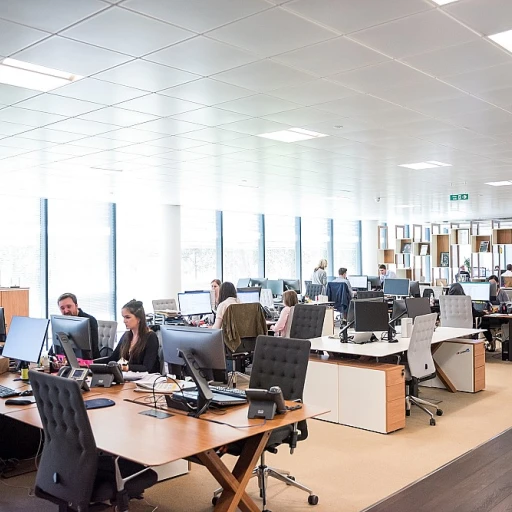Understanding the Employee Experience
Exploring the Core of Employee Experience
To set the foundation for a successful employee experience strategy, it's crucial to first grasp what the "employee experience" actually encompasses. In essence, it refers to the holistic perception that employees have regarding their journey with a company, encompassing every interaction from the initial job application to their final day at work.
Understanding the employee experience means appreciating the significance of every touchpoint in this journey. Each stage, be it during onboarding or throughout career development, contributes to how employees feel about their workplace. This feeling, in turn, can significantly influence their loyalty, productivity, and overall engagement. Essentially, a positive experience is likely to create ambassadors of your brand, while a negative one might lead to disengagement and high turnover rates.
The challenge lies in identifying what influences these perceptions and how to manage them effectively. Consider the broader role of a Chief Human Resources Officer (CHRO) in crafting company culture. By understanding how the CHRO shapes company culture, you gain insights into transforming superficial, segmented efforts into a united, strategic approach that fosters a thriving work environment.
As you embark on building an effective strategy for employee experience, you'll need to focus on interconnected areas. This includes defining a robust plan that outlines key elements such as the role of employee engagement and enhancing the workplace environment. By weaving these components together, you create an overarching narrative that supports every phase of the employee life cycle and enables continuous improvement through leveraging feedback.
Our exploration into effective employee experience management will continue to expand upon these interconnected areas, guiding you step by step toward crafting a comprehensive strategy that benefits both your organization and your workforce.
Building an Effective Employee Experience Strategy
Strategic Foundations for Successful Experiences
When it comes to crafting a comprehensive plan for improving employee experiences, establishing a strong foundation is crucial. This involves understanding the dynamics and needs specific to your workforce, which directly influences the strategic decisions you make. By aligning the company’s goals with the desires and expectations of your employees, you ensure that the initiatives put in place to enhance their experiences are not only effective but also sustainable.
Defining Targeted Goals and Objectives
An effective approach to building an employee experience strategy is to clearly define what success looks like for your organization. This involves setting tangible goals and objectives that address unique challenges within your work environment. Whether it’s improving communication, increasing access to resources, or fostering a sense of belonging, goals should be specific and measurable, providing a clear path forward for implementation.
Integration and Coordination
Creating a seamless employee experience requires the integration of various organizational aspects, such as company culture, employee engagement, and lifecycle development. Integrating these elements ensures that they are not functioning in isolation but are instead coordinated to reinforce each other. This holistic approach not only enriches the employee journey but also makes the organizational environment more cohesive and supportive.
For a deeper understanding of how the Chief Human Resources Officer (CHRO) influences company culture—a key element in shaping the overall employee experience—consider exploring how the
CHRO shapes company culture. This insight can be invaluable in aligning leadership strategy with employee-focused goals, enhancing both the strategic framework and its execution.
The Role of Employee Engagement
Empowering Your Workforce Through Engagement
Employee engagement is often at the core of an effective experience strategy. Embracing the concept of engagement means fostering an environment where employees feel valued, motivated, and passionately connected to the organizational goals. This connection is vital because it directly influences productivity, job satisfaction, and retention rates.
One way to cultivate this connection is by recognizing the unique role each staff member plays within the organization. Providing opportunities for employees to partake in decision-making processes can empower them and increase their sense of ownership. Moreover, celebrating accomplishments, big or small, and offering incentives can boost morale and engagement.
Open communication channels also play a crucial role in driving engagement. Encouraging employees to share their ideas and feedback not only helps them feel heard but also paves the way for ongoing improvements in organizational practices. Check out our
wellness initiatives guide for more strategies to boost employee morale and participation.
Lastly, ongoing learning and development opportunities are essential in maintaining high levels of engagement. When employees see that their personal and professional growth is a priority, they're more likely to remain committed and invested in their roles. As explored in our preceding section on building an effective strategy, creating tailored pathways for growth sustains engagement over the long haul.
Remember, building a culture of engagement requires intentionality and continuous effort. By integrating these elements into your employee experience strategy, you can effectively harness the power of engagement to drive success both for your employees and your organization.
Enhancing the Workplace Environment
Transforming Physical and Digital Workspaces
Creating a place where employees feel comfortable and productive is crucial to an effective employee experience strategy. It begins with ensuring the physical and digital work environments are designed with the employees' needs in mind. Comfortable workspaces, ergonomic furniture, and access to the right technological tools can go a long way in boosting morale and efficiency.
Fostering Inclusivity and Diversity
Enhancing workplace environment also involves fostering a culture of inclusivity and diversity. When employees feel valued and accepted, irrespective of their background, they are more likely to engage positively with their work. Strategies for promoting inclusivity might include diversity training sessions, creating employee resource groups, and implementing fair recruitment practices.
Aligning with Employee Values
Aligning the workplace culture with employee values is another critical aspect. Understanding what motivates employees and finding ways to incorporate those elements into the daily work routine can lead to higher satisfaction. Offering flexible work hours, promoting work-life balance, and encouraging personal development are effective ways to align workplace environment with employee values.
Encouraging a Vibrant Social Atmosphere
Don't underestimate the power of a positive social atmosphere at work. Events like team-building activities, celebrating birthdays, or organizing informal gatherings help build camaraderie among team members. A vibrant social environment can mitigate stress and promote collaboration, further enhancing the overall employee experience.
The Employee Life Cycle: From Onboarding to Development
From Welcoming New Hires to Fostering Growth
The employee life cycle is a pivotal aspect of any successful employee experience strategy, encompassing every stage of an employee's journey within the company. This journey begins with onboarding, a crucial phase that sets the tone for the entire employee experience. A well-structured onboarding process not only helps new hires acclimate to their roles but also integrates them into the company culture, fostering a sense of belonging from day one.
As employees settle into their roles, the focus shifts to nurturing their development. Providing opportunities for professional growth is essential in maintaining engagement and motivation. This can include offering training programs, mentorship opportunities, and clear pathways for career advancement. Such initiatives not only enhance individual capabilities but also contribute to the overall success of the organization by ensuring that employees are continually evolving and contributing at their highest potential.
Moreover, recognizing and celebrating milestones throughout an employee's tenure can significantly boost morale and reinforce their connection to the company. Whether it's acknowledging work anniversaries or personal achievements, these gestures demonstrate a genuine investment in employees' well-being and professional journeys.
Incorporating feedback mechanisms at each stage of the employee life cycle is vital for continuous improvement. Regular check-ins and performance reviews provide valuable insights into employee satisfaction and areas where the organization can enhance its support. By actively listening to employees and adapting strategies based on their feedback, companies can create a more dynamic and responsive workplace environment.
Ultimately, a comprehensive approach to the employee life cycle not only enhances the individual experience but also strengthens the organization's ability to retain top talent and maintain a competitive edge in the market.
Leveraging Feedback for Continuous Improvement
Gleaning Insights from Employee Feedback
Effective feedback is the cornerstone of an adaptable and resilient employee experience strategy. It creates a two-way street for communication, empowering employees and offering leaders valuable insights needed for continuous improvement.
Organizations that prioritize feedback cultivate a culture of openness and trust, where employees feel heard and valued. Establishing mechanisms for collecting feedback is essential, such as regular surveys, suggestion boxes, or open floor meetings, which encourage employees to voice their opinions and share their experiences. It's important, however, that feedback is not simply collected but acted upon.
When feedback is thoughtfully analyzed and integrated into strategic decisions, it promotes an environment where employee engagement thrives. This connection between feedback and actionable change reflects positively on organizational performance, inspiring loyalty and reducing turnover.
To truly leverage feedback, organizations must also consider its role within the entire employee life cycle. From onboarding to development, continuous feedback ensures that each stage is optimized and aligned with the firm's overarching goals, facilitating a seamless and motivating work journey for every employee.
In summary, by weaving feedback into the fabric of your employee experience strategy, you lay the groundwork for a vibrant workplace culture where continuous improvement is not just an aspiration, but a reality.








